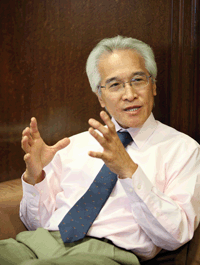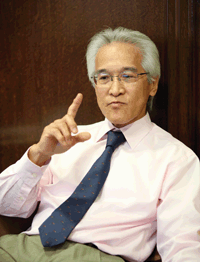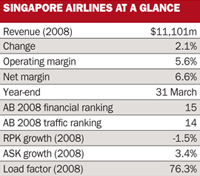After last year's downturn, it became fashionable for full-service carrier chief executives to speak as though the sky was about to fall down on them. Don't expect that from Singapore Airlines chief executive Chew Choon Seng.
Optimism is ingrained deep into the SIA culture - how else would it have become so successful with a small domestic market and no natural hinterland? Chew, a 40-year industry veteran, is candid about the challenges airlines face despite the downturn.
At the start of the hour-long interview at SIA's long-term headquarters, which overlooks Singapore's Changi Airport, he dispatches an executive to find a model of the Airbus A380 in SIA colours to replace a Boeing 747 for the photographs. "The future is bright, despite what others might say, and this aircraft represents that future," he says with a smile. It is easy to say that when you are SIA - an industry benchmark and the world's biggest carrier by market value. But the airline's executives - from Chew himself down to the baggage handlers - work very hard to make it that way, and are proud to be part of the SIA family.
 |
|---|
© Law Kian Yan |
Many have tried, with varying degrees of success, to replicate the Singapore Airlines model. The service and product advantages SIA had in the 1980s and 1990s are certainly more common across the industry. But SIA's Singapore Girl will still give you consistently good service more that most others, its aircraft average just over six years' old and are among the youngest, and SIA's in-flight amenities and product continue to set the standard. It also helps to have a hub that is a major transit point for passengers who travel worldwide - often on SIA's extensive network.
But the downturn has had its impact and SIA might have to post its first fiscal full-year loss after falling S$466 million ($335 million) into the red at the interim mark. But it could avoid that fate by a squeak if the recovery in passenger numbers and yields over the last few months is sustainable.
Older aircraft such as SIA's Boeing 747-400s and 777-200s are considered surplus to requirements and their retirement has been accelerated, with newer A380s, A330s and 777-300ERs that carry more passengers at a lower cost replacing them.
Cathay Pacific Airways wonders if it should tweak its business plan, Qantas Airways is relying even more on its low-cost subsidiary Jetstar, and the Association of Asia Pacific Airlines is warning that the recovery may not be sustainable. SIA, however, carries on, confident in the sustainability of a business model centred on the premise that the discerning passenger is willing pay a premium for quality. This is especially true in the front end of the aircraft, on which SIA is hugely dependent.
"The reports of the death of luxury have been exaggerated," says Chew. "There will still be a segment of the market that is prepared to pay for space, comfort, privacy and attention, top drawer food and drinks, as well as top quality, high-end fittings in terms of in-flight gizmos and so on."
What has happened over the last year - something that takes place in almost every economic downturn - is that customers have become more price-sensitive, he adds. SIA knocked down fares to increase its loads, but it was one of the first to rollback promotions once the recovery began and the statistics showed that the traffic was returning. The downturn was another trough - albeit a deep one - in an extremely cyclical industry, says Chew.
"One of the questions all airlines have to face is whether the change in demand that we have seen in the past year is structural or cyclical. I tend towards the latter view, that this is more reflective of the downturn in the economic cycle. The subtext is how long this trough will last and when we will see an uptake," he points out. "Heaps of people" at SIA studied the effect of the downturn and recommended that the carrier carry on - with some tweaks. On some routes the carrier now operates 777s without any first class seats. But contrary to expectations, it kept the all-business class, non-stop services on Airbus A340-500s to New York and Los Angeles. Both moves have proven to be successful.
 |
|---|
| JOB FOR LIFE At 63, Chew Choon Seng is past retirement age and his contract with SIA expires this December. There is no indication of whether it will be extended, but sources say the board is looking at possible replacements. "I would pass the baton on to the next generation, in the same way that I received the baton from those who left before me," says Chew, who joined the carrier in 1972. "In the fullness of time, we will make the appropriate moves public. I am quite realistic. Nobody is really indispensible." But Chew has no regrets about spending his career in this "challenging" industry: "There have been many frustrating moments, sad moments, but many good moments too." Do not expect him to be playing golf after retirement, though. "I tried it once but never got into it. It just consumes too much time." Any free time, then, is spent doing "the usual things - one reads books, one listens to music, one argues with the wife", he quips. |
"We have come to the conclusion that there will still be a viable volume in the high-end, premium, full-service network model which SIA has built itself on. Our perseverance through the early part of the downturn until mid-2009 has been vindicated by the fact that non-stop to New York has been running near-full capacity these last few months."
The biggest change from the downturn is in the short-haul segment, such as services to Kuala Lumpur and Penang. After Singapore and Malaysia liberalised their air services agreement to allow low-cost carriers, SIA's smallest aircraft, the 777, became too large to compete on these "commuter" services. Its pragmatic management decided that regional subsidiary SilkAir, and its A320s, made more sense on the frequency needed to compete against the likes of AirAsia, Jetstar Asia and SIA's associate Tiger Airways.
This is a shift of the Asian airline passenger market closer to the European and US sectors, which have higher demand for flights with fewer frills on the short-haul sectors. Both low-cost and full-service carriers meet that requirement in their own way.
The next threat could come in the long-haul market. Kuala Lumpur-based AirAsia X is already flying to London and Sydney - key markets for SIA. Qantas subsidiary Jetstar, which has an associate in Singapore, is also studying long-haul flights from the island. Chew calls this "an interesting model", but he is quick to add that SIA will prevail.
"It is one thing to ask passengers to pay $2 or $5 for a drink on a short-haul flight that is only 45 minutes long, but it is another thing on a 13.5 hour flight to London." Pointing to the model of the A380, which SIA has deployed to high volume destinations like London, Sydney, and Tokyo, he wonders if the low-cost carriers can really compete.
"It is debatable if a purely long-haul, low-frills carrier can, given the small scale with which it inevitably has to start with, can be competitive enough on a unit-cost basis with what we can produce on the main deck of a big bird like the A380 that flies three times a day to London. We looked at it. Even if you configure the 777-300, in terms of seating, the unit cost is not much lower. We can mix traffic and cargo - and the economies of scale are there. It remains to be seen if the competition can be sustainable." The markets are also different, he adds. AirAsia X focuses on the student, backpacker, and shoestring tourist traffic - although it also eyes some business traffic for its premium seats. "There will be a market for such basic no-frills operations if the fares are low enough," Chew concedes.
Increasingly, it looks as though the likes of SIA and AirAsia will divide the Asian market up between them, leaving the other middle tier full-service carriers in a "squeeze", as Chew puts it. The greater challenge could come from Gulf carriers like Emirates, Etihad and Qatar. Their product is similar to SIA's, and their home bases of Dubai, Abu Dhabi and Doha are a threat to Singapore on key routes between Europe and Australia.
"There is a place for everybody," says Chew. "Their growth and success did not catch us off guard. What I must admit was left field to me was that, suddenly, three or four carriers from the same area would all be underpinned by massive investments in airport infrastructure, and all within an hour or so flying distance of each other."
Competition, he adds, will spur SIA on. "Just as we competed with the established players, we must expect that others will compete with us and try to better us. That will keep us on our toes and keep our organisation vibrant and teach us never to rest on our oars. We must continue to row against the tide."
Gulf carriers may grab the headlines for their huge aircraft orders, but SIA prefers to be in the news for other reasons. "We don't aim to be the biggest player. SIA is not the biggest player. We aim to be the most profitable and number one with customers. Having our customers rate us well, preserving customer loyalty, serving their needs. That, for me, is paramount. Size, per se, is not important."
Customers, he adds, will ultimately decide on Gulf carrier success: "Judging by the size of their new aircraft orders, one begins to wonder if they think if the rest of the world is just going to roll over and play dead. Not everyone is keen to transit airports in the Gulf. There will always be markets for hubs elsewhere. There will be hub competition, carrier competition, but most importantly carrier choice."
Chew has long-bemoaned the industry's struggle to achieve consistent profits, even in the best of times, a point which he made writing a column in the Airline Business 20th anniversary edition in 2005. "That is the conundrum," says Chew. "The industry has all the wrong fundamentals. It is capital and people intensive, there are low barriers to entry, it is a big user of an energy commodity that is highly volatile in price. It attracts lots of players, people who ought to know better, wasting their money starting up airlines. Because of open competition and ease of entry, you can be reduced in pricing to your least intelligent competitor."
Moving to one of his long-time gripes, he says governments add to the problem by propping up unprofitable flag carriers for nationalistic reasons. In the last year, China, India and Japan have tried to keep their carriers alive in the face of massive losses due to the downturn and high fuel costs. "Don't ask me why. That is what the politicians do," he says with a shrug. "At some point in time, as it appears to be in Japan now, tax payers will get tired of bailing out fading companies. We have seen it in the car industry and through the furore at the finance industry and their salaries. It will change, it's just question of when some momentum will start." Then with a hearty laugh, he adds: "But I am not holding my breath - I am too old to do that."
Resistance to liberalisation is another pet peeve. He welcomes the US-Japan Open Skies agreement and the Australian government's decision to allow more competition on the trans-Pacific routes. SIA has not immediately benefited from these changes. It is still not allowed to add more USA-Japan services, or fly larger aircraft on the routes, and it does not have rights across the Pacific from Australia. But it continues to champion fifth freedom rights for third-country carriers like itself. "It is the principle of equality of opportunity. We want the same opportunities beyond Australia that Qantas enjoys beyond Singapore. Whether we choose to exercise it or not, SIA has always been a responsible player. We do not do things just to make money. I am only happy that the interest of the Australian consumer is taken care of." He quickly adds: "And I say that with a straight face."
Cynics may snigger, but Chew fundamentally believes in the benefits that airlines bring around the world. "At its heart, the industry provides a service that is wanted by people, more so in this globalised economy. It is arguably essential in modern day trade, business, social community, world development."
What should SIA do to keep up its premier place in this key industry? In a departure from its past strategy, Chew says that the carrier is not looking to use its cash position to buy a stake in a foreign carrier - especially since cross-border regulations restrict it to minority stakes. This comes from the lessons learned in its less than successful investments in Air New Zealand and Virgin Atlantic.
"What has it taught us? Well, we are a few hundred million dollars smarter," he says with a wry smile, before adding frankly. "Those two investments did not work out. We have concluded that minority positions will be meaningful to us only if we have some role to play in the strategy formation and policy decisions, as well as creating real synergies that have lasting value and beyond what we can normally achieve within alliances."
That knowledge comes as SIA comfortably moves into middle age: it turns 40 in 2012. But Chew says it will not suffer from a mid-life crisis. Instead, it will continue to focus on its employees, who took pay cuts and compulsory leave in 2009 to help trim costs, with Chew himself accepting a 20% cut.
Chew believes people are key to SIA's success: "Any budding airline with funds can buy the same planes, the latest computers, a fancier headquarters than what we have. But at the end of the day, this is still a people-intensive industry. From the moment you speak to a sales agent, to boarding the plane, to picking up baggage, it is people." This critical asset underpins any future reinvention and innovation. "That will be the challenge - to ensure SIA does not lose that spirit."
FEELING THE HEAT Want to see Chew Choon Seng get worked up? Just bring up the flack that the industry gets from the green movement. He agrees airlines should do their part to help the environment, but those who try to make an example of the industry get his goat. "How did all those people go to Copenhagen? I'm sure they did not walk there," he says. "In 2006, there were some elements of industry that were still in denial about responsibility for our share in protecting the environment. We have now gone to the stage of stepping up to the plate, and accepting that we do contribute to carbon emissions and gaseous emissions." But he adds that the solution must be a "universal project" and cannot come from one country, economic unit, industry group, or airline. Measures like the UK green tax also rile him: "It is a shambolic masquerade of what is really a money grabbing venture. The Brown government has not planted a single tree or installed a single wind farm with the hundreds of millions of pounds they have collected. In fact, if you calculated it, the APD collections would have paid for all the carbon credits the industry needs to pay in a year." EU emissions trading is another bugbear. "If they confine everything to within EU, then that's a separate matter. But it's the principle of imposing levies on foreign operators, starting from point of origin." Even if the EU proceeds, he argues that the tax should be confined to flight time within its own airspace. "IATA and the various regional associations have been vocal - the trouble is that there are none so deaf as those who won't hear." |
Source: Airline Business

























